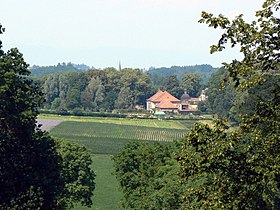Vullierens
| Vullierens | |
|---|---|
| State : |
|
| Canton : |
|
| District : | Morges |
| BFS no. : | 5654 |
| Postal code : | 1115 |
| UN / LOCODE : | CH VUS |
| Coordinates : | 526 659 / 158394 |
| Height : | 528 m above sea level M. |
| Height range : | 460-583 m above sea level M. |
| Area : | 6.84 km² |
| Residents: | 508 (December 31, 2018) |
| Population density : | 74 inhabitants per km² |
| Website: | www.vullierens.ch |
|
Vullierens Castle |
|
| Location of the municipality | |
Vullierens is a municipality in the Morges district in the canton of Vaud in Switzerland .
geography
Vullierens lies at 528 m above sea level. M. , 7 km north of the district capital Morges (linear distance). The village extends on a slope slightly to the east above the Senoge valley, in the western Gros de Vaud in the Vaud Central Plateau .
The area of the 6.8 km² municipal area includes a section of the Gros de Vaud, the granary of the canton of Vaud. The municipality extends from the broad valley of the Senoge westward to the extensive plateau of Vullierens and reaches Mont Bournet at 585 m above sea level on the hill . M. the highest point of the municipality. The forested valley of the Broye (side stream of the Senoge, not to be confused with the Broye ) occupies the north-eastern part of the municipality . In the south the area extends to the En Ombre hill ( 569 m above sea level ) and in the southeast over the Senoge to the height of Saint-Saphorin-sur-Morges (up to 525 m above sea level ). In 1997, 6% of the municipal area was accounted for by settlements, 9% for forests and woodlands and 85% for agriculture.
Vullierens includes the hamlet of Gland ( 534 m above sea level ) northeast of the village on the edge of the plateau and a few individual farms. The neighboring municipalities of Vullierens are Aclens in the south-east, Echichens in the south, Cottens in the west, Grancy in the north-west, Senarclens in the north and Gollion in the north-west .
population
v Vullierens is one of the small communities in the canton of Vaud. 92.3% of the residents are French-speaking, 3.2% English-speaking and 3.0% German-speaking (as of 2000). The population of Vullierens was 514 in 1900. After the population had decreased to 333 inhabitants by 1970, a slight increase in population was observed again.
economy
Vullierens was a predominantly agricultural village until the second half of the 20th century . Even today, agriculture has an important role in the income structure of the population. On the western slope of the Senoge there are several small wine-growing areas (a total of 17 hectares). Further jobs are available in local small businesses and in the service sector. In the last few decades the village has developed into a residential community. Many workers are commuters who work mainly in Lausanne.
traffic
The community is located off the main thoroughfares, but has good connections with the neighboring villages. It is located on the cantonal road from Aclens to Cottens . Vullierens is connected to the public transport network through a Postbus course that runs from Morges via Cottens to Cossonay .
history
The first written mention of the place took place in 1047 under the name Vuilerens . The names Wilerens (1049), Willerens (1221), Willereins (around 1250), Wulierens (1263) and Willierens (1345) appeared later . The place name goes back to the Burgundian personal name Wilihar and means for the people of Wilihar .
Vullierens has been under the lords of Cossonay since the Middle Ages . The aristocratic family de Vullierens has been documented since the 12th century. In 1421 the village came to the de Colombier family, later ownership changed several times. With the conquest of Vaud by Bern in 1536, Vullierens came under the administration of the Bailiwick of Morges . After the collapse of the Ancien Régime , the village belonged to the canton of Léman from 1798 to 1803 during the Helvetic Republic, which then became part of the canton of Vaud when the mediation constitution came into force . In 1798 it was assigned to the Morges district.
Attractions
The current parish church was built in 1733 on the site of a previous medieval building. South of the village is the baroque castle, which was built between 1706 and 1712. The main building has two lower wings and contains a theater hall. The palace garden is known for its iris cultures (around 500 species are shown) that bloom in June. In the town center there are some characteristic farmhouses from the 17th to 19th centuries.
Web links
- Official website of the municipality of Vullierens (French)
- François Béboux: Vullierens. In: Historical Lexicon of Switzerland .
- Aerial photography
- Château de Vullierens (French)
- Iris garden of Vullierens (French)
Individual evidence
- ↑ Permanent and non-permanent resident population by year, canton, district, municipality, population type and gender (permanent resident population). In: bfs. admin.ch . Federal Statistical Office (FSO), August 31, 2019, accessed on December 22, 2019 .




